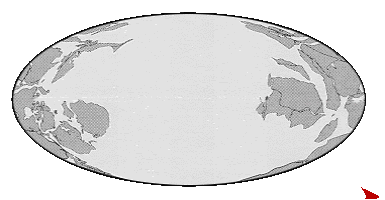Besides the ocean spreading ridges there are several mysterious “hot spots” evident in seamount chains where volatile components of the mantle emerge at a point as a more or less continuous volcano. The most famous of these is the Hawaiian/Emperor seamount chain and the Hawaiian “hot spot”.
The classical notion of the tectonic evolution of North America is that such a hot spot burned its way up the current path of the Columbia River and now resides beneath Yellowstone. Below we will time step through the existing surface rocks to evaluate this notion.
We start in the Paleocene, just after the dinosaurs bought the farm and the great central seaway that had occupied the plains states for fifty million years was pretty well dried out. We see some remnants of this seaway in Paleocene sediments in the plains of Montana and Wyoming. Pretty quiet. Some volcanics and related sediments along the Oregon coast, some volcanics in central Oregon that extend marginally to the Modoc Plateau of California, and the fingers of sediment in an intermontane seaway in central Utah.
Next we go to the Eocene. This is the time of the so called “Laramide” orogeny and we can see volcanics popping up around the Achaean granite plutons in Colorado, the Absaroka field in Yellowstone, and the Mesozoic Idaho Batholith. We also see new granites forming in Montana, Idaho, Nevada, and Utah. Volcanism continues in central Oregon and extends up the coast into Washington. It is worth noting that the Yellowstone volcanic fields were well established in Laramide time.
The Oligocene is notable for a wave of volcanics across the Great Basin. We are still waiting for any indication of a hot spot systematically burning its way to Yellowstone.
In the Miocene we get some serious action with volcanics covering large areas of California, Nevada, Oregon, Washington, and Idaho. The state geologists could have done a better job coordinating colors of what are obviously continuous units.
The Pliocene shows only a continuation and infill of the Miocene volcanics and valley sedimentation.
In the Pleistocene we finally get the Columbia River basalts filled in with related volcanics extending to join the Absaroka field in Yellowstone established forty-five million years earlier. The Great Basin is filled with sediments.
The notion of a Yellowstone hot spot has always been generally associated with the ocean spreading ridge that remains offshore northern California, Oregon and Washington. Weak subduction from this ridge is believed to cause the volcanism in the Cascade Range. The evolution of volcanics in the western United States is more consistent with general uplift as the continent passed over the linear mantle upwelling below the ridge than from the focused activity of a “hot spot”.













